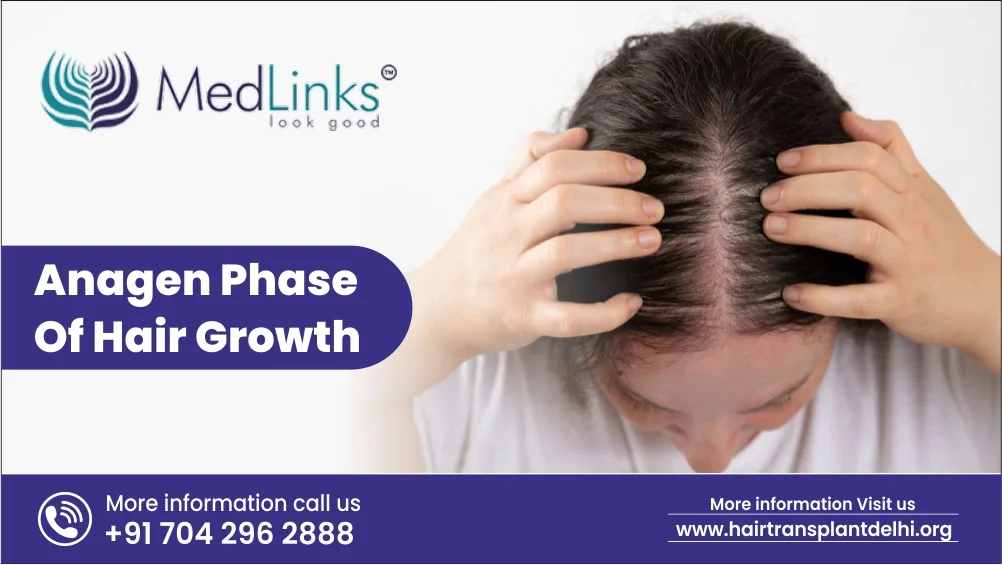The hair growth cycle is a dynamic process involving multiple stages that ensure hair continues to grow, rest, and renew itself. One of the most critical yet often misunderstood stages is the Exogen phase, also known as the shedding phase. This phase plays a significant role in the natural hair growth process, as it is responsible for the release of old hair to make room for new growth. In this blog, we’ll dive into the details of the Exogen Phase of Hair Growth, its importance in hair health, and what you can expect during this phase.
What is the Exogen Phase?
The Exogen phase is the final stage of the hair growth cycle and involves the shedding of hair strands from the scalp. This phase is a natural part of hair renewal, during which old hairs are released from their follicles, and new hairs begin to emerge. While shedding is a normal aspect of healthy hair growth, the rate of shedding and regrowth can vary from person to person.
Typically, humans shed 50 to 100 hairs per day during the Exogen phase. This may sound alarming, but it is entirely normal. The shedding hairs are often those that have reached the end of their lifespan and are being replaced by new, growing hairs.
The Hair Growth Cycle: A Quick Recap
To better understand the Exogen phase, let’s briefly revisit the hair growth cycle. The cycle is made up of four main stages:
- Anagen Phase (Growth Phase): This is when the hair actively grows, lasting 2 to 7 years.
- Catagen Phase (Transition Phase): A brief phase lasting about 2 weeks, where hair growth stops, and the follicle begins to shrink.
- Telogen Phase (Resting Phase): A resting period lasting 3 to 4 months, where the hair remains in the follicle but does not grow.
- Exogen Phase (Shedding Phase): The stage where old hairs are released from the follicle, and new hairs begin to grow in their place.
Each hair follicle is independent and can be in different phases of the cycle at any given time, ensuring that not all hair sheds simultaneously.
How Long Does the Exogen Phase Last?
The duration of the Exogen phase can vary, but it typically lasts for 2 to 4 months. During this time, hair follicles gradually loosen their grip on the old hair strand, allowing it to fall out naturally. Once the old hair has shed, the follicle re-enters the Anagen phase, beginning the growth of a new hair strand.
Hair shedding during the Exogen phase may not always be noticeable, as most people lose a small, manageable number of hairs per day. However, there are instances where the Exogen phase may become more prominent, leading to visible hair thinning or increased hair fall.
What Happens During the Exogen Phase?
The Exogen phase is essentially the renewal process of your hair. Here’s what happens during this stage:
- Old Hair is Released: Hair that has completed its growth cycle is slowly pushed out of the follicle, detaching from the scalp.
- New Hair Starts Growing: Even as the old hair sheds, a new hair strand is often already growing beneath it, deep within the hair follicle, which will eventually emerge during the Anagen phase.
- Natural Shedding: During the Exogen phase, hair strands fall out naturally, usually while brushing, washing, or even just running your hands through your hair.
Although the Exogen phase primarily involves hair shedding, it is also crucial for the renewal process. It allows the scalp to make way for new, healthy hair to grow in its place.
Factors That Can Affect the Exogen Phase
While the Exogen phase is a natural part of the hair growth cycle, several factors can influence the amount of hair shedding and the overall duration of this phase. These include:
1. Hormonal Changes
Hormonal fluctuations due to pregnancy, menopause, or conditions like thyroid disorders can affect hair shedding. For example, women often experience increased hair shedding after giving birth due to hormonal shifts. Similarly, conditions like hypothyroidism can cause excessive shedding during the Exogen phase.
2. Stress
High levels of stress can trigger hair to enter the Exogen phase prematurely, leading to more hair shedding than usual. This is often seen in cases of telogen effluvium, where stress, illness, or trauma can push more hair follicles into the resting and shedding stages at the same time.
3. Medications
Certain medications, such as chemotherapy drugs, birth control pills, or blood thinners, can increase the shedding of hair. These medications may accelerate the Exogen phase, causing hair to fall out more quickly than it normally would.
4. Nutritional Deficiencies
A lack of essential nutrients like iron, zinc, biotin, or protein can weaken the hair and increase the rate of shedding. In such cases, the Exogen phase may last longer, or more hair follicles may enter this phase prematurely.
5. Age and Genetics
As we age, the hair growth cycle can become shorter, and the shedding phase may become more noticeable. Genetics also play a role in determining how much hair is shed and how quickly it regrows. Some individuals are genetically predisposed to experience more hair shedding or thinning as they age.
Excessive Shedding During the Exogen Phase: When to Worry?
While shedding 50 to 100 hairs per day is normal, excessive hair loss can be a cause for concern. If you notice the following signs, it may be time to consult a dermatologist or hair specialist:
- Clumps of Hair in Your Brush or Shower: If you’re shedding significantly more than usual, such as clumps of hair coming out during brushing or washing, it could indicate an underlying issue.
- Visible Thinning or Bald Spots: If hair loss is more than just shedding and you notice thinning or bald patches, it may suggest a more serious condition like alopecia areata or telogen effluvium.
- Prolonged Shedding: If excessive hair shedding persists for several months without improvement, it’s important to investigate possible causes such as nutritional deficiencies, hormonal imbalances, or chronic stress.
Early intervention and treatment can help manage excessive shedding and promote the regrowth of healthy hair.
Tips to Manage the Exogen Phase and Reduce Shedding
Although shedding during the Exogen phase is normal, there are ways to ensure that it doesn’t become excessive or problematic. Here are a few tips to manage this phase and keep your hair healthy:
- Maintain a Healthy Diet: Ensure your diet includes essential nutrients like biotin, zinc, iron, and protein, all of which are critical for strong, healthy hair.
- Manage Stress Levels: Practice relaxation techniques such as meditation, deep breathing, or yoga to reduce stress, which can impact hair shedding.
- Avoid Harsh Treatments: Minimize the use of heat styling tools, chemical treatments, and tight hairstyles that can weaken hair and increase shedding.
- Use Gentle Hair Care Products: Opt for sulfate-free shampoos and conditioners, which are gentler on the scalp and hair.
- Consult a Specialist: If you’re experiencing excessive shedding, consult a hair specialist who can diagnose the cause and recommend appropriate treatments.
Conclusion
The Exogen phase is a normal and essential part of the hair growth cycle, responsible for shedding old hairs and making way for new ones. While hair shedding can be a cause for concern when excessive, understanding the Exogen phase can help you manage your expectations and take proactive steps to maintain healthy hair. By following a healthy lifestyle, managing stress, and seeking professional help when necessary, you can ensure that your hair goes through the shedding phase smoothly and that new growth follows quickly.






